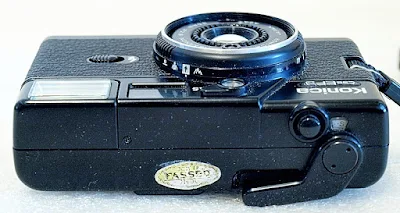The Konica C35 EF3, launched in 1981, was the final iteration of the zone-focus Konica C35 compact 35mm film camera model. An update of the Konica C35 EF (or the 'Pikkari' as it was nicknamed in Japan), the C35 EF3 was initially made available in three colors - Red, Blue, and Black. The range was later expanded to include Silver, White, Yellow, and Blue Metallic, making it 7 colors in all.
The C35 EF3 has a form factor that is slightly smaller and has a more stylish outlook than its predecessors. Instead of the 38mm F2.8 Hexanon lens as fitted to previous models, the C35 EF3 is fitted with a 5-element in 4-groups Hexanon 35mm F2.8 lens and takes the same size 43mm screw-in filters as the others.
Metering is still via a CdS metering cell, with the exposure setting locked with a half-press of the shutter release button. The shutter speed range is from 1/60 to 1/500 second, the film ISO speed range is from ISO 25 to 400, and the camera requires a set of 2xAA batteries to power both its shutter and flash unit.
1981 Konica C35 EF3 - Vintage Film Camera
The 1981 Konica C35 EF3. One of a range of C35 point & shoot 35mm cameras that were made by Konica from 1968 until 1984. They started as rangefinders and later autofocus, but this is one of the zone-focusing models. Mine is black, but they came in various colours and now seem to becoming popular again. It's a pretty standard point and shoot, but it is worth taking a look at the unusual setup with regards to the wind-back crank mechanism.
Basic Camera Features
Being actually a simpler version of the C35 series, the C35 EF3 has a rather regressive, plain and simple albada-type viewfinder screen etched with only a bright-line frame and a red LED unit located on the side of the viewfinder eyepiece for low exposure and flash use.The front of the camera is where all the happenings are - the lens and lens mount housing with the lens surrounded by the film ISO dial selector, film ISO display window, CDS meter bulb, and distance scale icon and numeral setting on the barrel of the housing mount itself.
Directly above the lens mount axis, along the front part of the camera's top plane, is the 10-second delay self-timer switch and timer display LED. The timer is set to ON when the arrowhead pointer is pushed upward, and the timer sequence is activated when the shutter button is released.
On the right of the self-timer set up, and flanked by the pop-up flash unit, which ends at the edge of the front panel, is the viewfinder window. The flash unit is set to ON by 'popping' it up using the flash pop-up release slide switch located on the front body panel.
The C35 EF3 has a rather plain top, with only the shutter release button, film forward lever, and a film counter window clustered towards the right end of the top of the camera.
On the back, a slide switch to lock in the film back, the viewfinder eyepiece with the LED unit next to it, and to the left, the flash-ready pilot light.
Away from the norm of having the film rewind crank located on the top plane of the camera, the C35 EF3 has its film rewind crank located on the bottom plate with a mechanism that lowers the folded rewind crank assembly automatically when the camera back is opened.
This also lowers the film rewind stub that locks into the bottom of the film canister when the camera is in use. In reverse, the assembly self-locks (maybe with the help of an upward nudge) when the film back is snapped closed.
Located on the bottom plane of the camera are also the film rewind release button and the tripod socket, which is located on an extended height footing that matches the height of the exposed film rewind crank assembly.
With the film rewind crank mechanism lowered, loading and unloading the film canister is a simple, quick loading process. Aside from the film frame window, a multi-slot take-up spool and an encased sprocket wheel assembly make up the rest of the film box.
Once the film back is loaded with a new roll of film, the standard two-blank shot is used to forward the film to Frame 1.
Viewfinder Readout
As mentioned earlier, the viewfinder of the C35 EF3 is a plain albada-type with only the frame and parallax bright-line indicated. The red LED display will light up when flash use is recommended and will flash again when the shot is taken.Battery
The C35 EF3 requires a pair of 2xAA batteries to operate. The battery power is used for both the electronic shutter release mechanism and for powering up the flashmatic flash unit.The camera's body weight is 275 grams without batteries.
Using The Camera
Aside from reminding myself to always set the zone focus distance to the right distance of the image I am taking, using the Konica C35 EF3 is fun and straightforward. It is almost the perfect point-and-shoot.Loading and unloading the film roll is explicitly easy, the film forward crank is smooth and faultless, and the pair of AA batteries should power the camera comfortably for the few rolls of film you are anticipating using.
One thing that I could not find across the net is the instruction manual for the camera, and not too many YouTube videos on it either.




















No comments:
Post a Comment